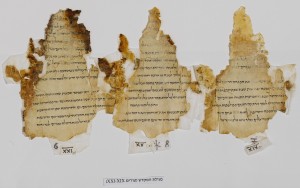Discovery Times Square Interview
When the Discovery Times Square Dead Sea Scrolls exhibit was running, I was asked some personal and scholarly questions about the Dead Sea Scrolls for the museum’s blog:
When did you first become interested in the Dead Sea Scrolls?
I began working on the Dead Sea Scrolls when I wrote my senior honors paper at Brandeis University in 1970. Then, when I was looking for a topic for my doctoral dissertation that would combine my fields of interest in Bible and rabbinic literature, I realized that the Dead Sea Scrolls were a perfect area of research for me. Of course, at that time only about one-quarter of the material was available, but there was still a lot of work to do.
Over your decades of study, what’s the most surprising thing you’ve learned about the Dead Sea Scrolls?
For me the most surprising thing was to realize that there was an entire library of texts that somehow didn’t enter the mainstream of Jewish literature and thought throughout the ages but that had been part of Jewish culture in Second Temple times, and which did in fact have important influences on Judaism and Christianity. It was amazing to learn how much could be learned from these texts about the history of Judaism and background of Christianity.
What do you think is the most important question that today’s Dead Sea Scrolls scholars need to answer?
I think we face the challenge of synthesizing what we are learning from the Dead Sea Scrolls with the related fields of study of Hebrew Bible, New Testament and the history of Judaism. The problem that we really face is that we have a small cadre of scrolls experts who have finally brought the material to the light of day and have achieved an amazing amount in creating the necessary research tools for wide dissemination of this new knowledge. We just have to make sure that this knowledge gets to the audience that needs it and can contribute most to its wider understanding. That’s why it’s so gratifying to see so many people coming to the exhibit and learning about the Dead Sea Scrolls.
Do you have a favorite scroll? If so, what is it and why?
My favorite scroll is the Temple Scroll. I’ve published two books on the scroll and I am planning a new addition and commentary on the scroll that I’ve really been working on for more than 35 years. It’s a rewrite of the Torah to which the author adds his own interpretation and laws and seems to represent a very valuable window onto the Sadduceeanpriestly trend of biblical interpretation and Jewish law. There’s so much to do in restoring, translating, and analyzing this text that it has absorbed me for years.
If you could go back in time and talk to the composer of one of the Dead Sea Scrolls—to find out why he wrote what he did—what scroll would it be and why?
I would love to speak to the authors of the document we call MMT, which is a foundation document of the Qumran sect, identified by most scholars with the Essenes. I’d love to ask the author of the MMT if I’m correct the issues of Jewish law pertaining to the Temple, and if [disputes over issues of] sacrifices and purity are one the fundamental causes of the schism between the Qumran sectarians and the authorities of the Temple. I would love to know if I’m right in claiming that the Qumran sectarians followed the approach of the Sadducees and oppose the approach of the Pharisees, which at that time had been adopted by the priestly leaders in the aftermath of the Maccabean Revolt(164-168 BCE).
Source: Scroll Expert Shares His Personal Experiences and More From Our Scroll Expert, Dr. Lawrence Schiffman


Leave a Reply